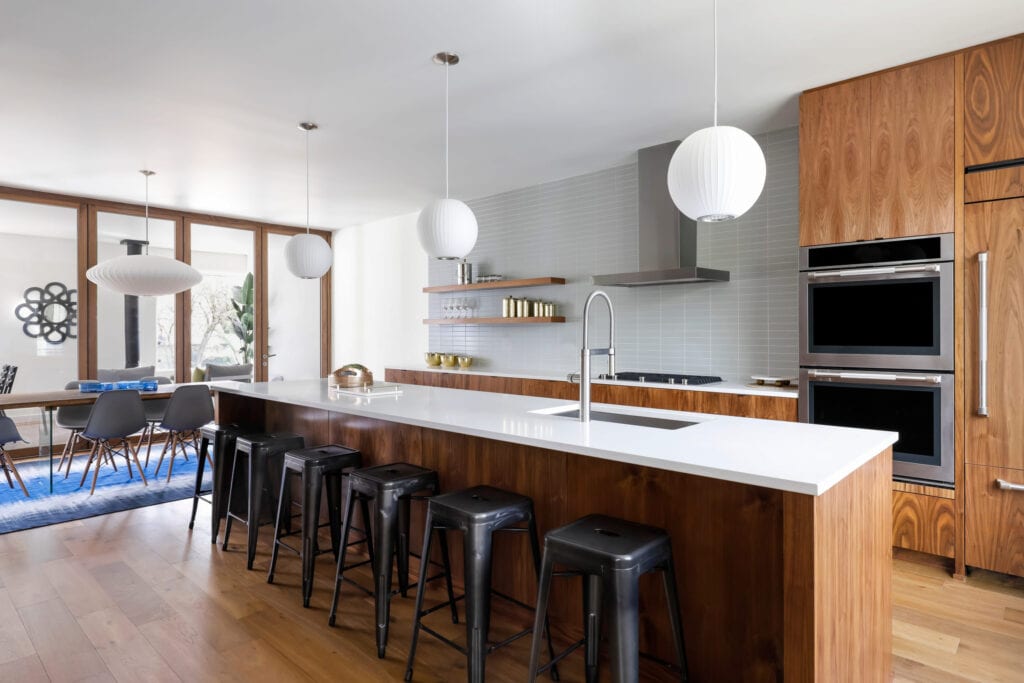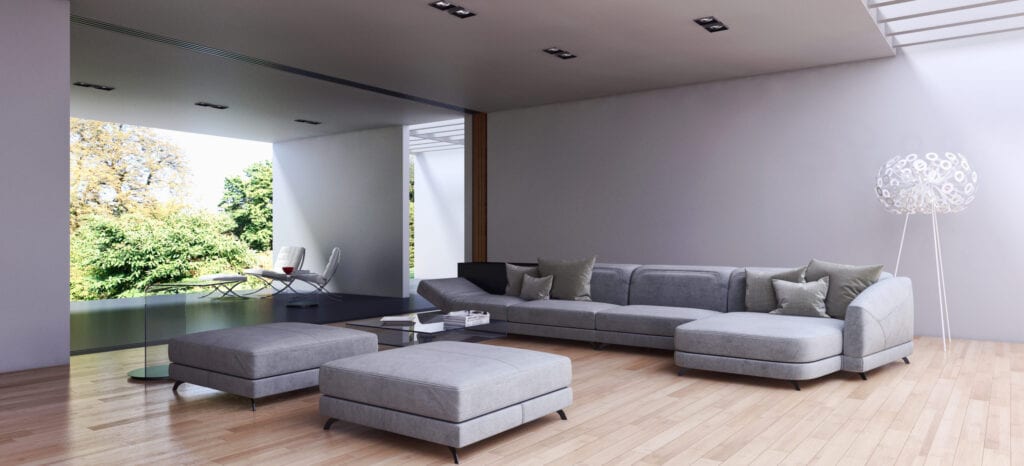Moving into a new home can be one of life’s great joys, but it can also be a time of uncertainty, especially when it comes to decorating. How do you make your space look its best while reflecting your personal sense of style? Do it well and you’ll end up with a comfortable, happy home. Do it poorly and you’ll end up with a hodge-podge of furniture, fabrics and paint colors that never congeal into a pleasing whole. With a little planning, and by following the same steps used by professional interior designers, you’ll have a much greater chance of success.
Home Decorating Tips

Light-colored furniture and plants create a homey feeling around this cozy dining room table.
Every house should be a warm haven, a place where we throw off the cares of the world and relax with family and friends. From the kitchen where we launch our busy days to the bedrooms where we close our eyes at night and dream, we want each space to reflect our personal tastes and sensibilities. But we desire that our rooms be comfortable and practical. Pulling all the components together is a tall order, and yet it’s also wonderfully rewarding. Use the home decorating tips we’ve provided here as inspiration, and create the kinds of rooms your loved ones will want to hurry home to enjoy.
Before you get to work tearing down walls or throwing the paint up on the walls, there are a few steps to take first. Take the time to formulate a decorating plan; it’ll save you time and money.
Decorating Tips for New Homes
If your home is being newly constructed, now is the time to get involved in decorating before the home is completed! Use these decorating tips for new homes, and learn how to make an imprint on your home before the contractors finish their job.
Integrating New Decorating Ideas
Decorating a room in a new style can clash with the old style in adjoining rooms. Learn how to integrate new decorating ideas throughout your home so that the style feels unified, not disjointed.
Form and Function in Decorating
Everyone wants their home to be pretty, but to make it inviting as well, it must live up to its function. Is there ample seating in the TV room for big families? Is there enough space in the entertainment room around the pool table to shoot? Learn how to combine form and function to create an ideal living space.
Tips for Starting a Decorating Project
Before your start decorating a room, it’s best to assess what you have to work with. Is the dry wall caving in? Is the plumbing leaking? Fix these things first, and then you’re ready to start your decorating project.
Tips for Decorating on a Budget
Most people can’t afford to undertake a huge endeavor, like decorating a room, without looking at the final price tag. If you’re decorating on a budget, these tips will help you achieve the look you want without the exorbitant cost.
Organizing a Decorating Project
These tips on organizing a decorating project will not only help you track your current undertaking but future ones as well. Plus, good organization can help you save money in the long run.
DIY Decorating vs. Using a Professional
Although do-it-yourself projects can be fun and rewarding, they aren’t always feasible. Unless you’re an expert at removing asbestos or wiring electricity, it’s best left to the professionals. Use these tips to determine what you can handle and what you should hire out to contractors.
1. Figure out your decorating style

If you can pin down the design style you want for your home’s interior, you’re half way there! An easy rule of thumb is to use the same style for the interior as the home’s exterior. With an architectural home style like ranch or craftsman, dark, rich wood pieces, clean-lined furniture and lots of earth tones work well.
Transitional

A transitional style goes with most home architectural styles. The look is a hybrid of modern and traditional — perfect for updating older home styles like colonial or Victorian, or warming up a new-construction home. The transitional home decorating style involves the use of dark woods, stone, neutral colors and earthy reds, sages and olive greens as accent colors. Furniture is fairly streamlined but features more ornamentation and curvier, softer lines.
Modern

A modern decorating style is well-tailored and features clean lines. Wood and earth tones add a softer feel to the clean straight lines. Mid-century modern sofas or elements are popular. Ranch homes, Art Deco-era homes, and homes constructed during and after the 1950s tend to work best with modern decor.
Contemporary

Contemporary design is the most sparse and minimalist of the design styles. Few pieces are used in each room. Color selection is normally pared down to black, white or grey with primary color accents. Metals and glass, instead of wood, are featured. When decorating from scratch, a contemporary style is a good idea when you’re working with smaller spaces and/or you want to highlight the home’s natural features, like big, bright windows or architectural details.
Farmhouse

Farmhouse is very popular nowadays thanks to designers like Joanna Gaines. The style adds fun, cozy comfort and a bit of whimsy to your new home. To decorate from scratch in a farmhouse style, practical, cozy and inviting are most important. Sofas should be overstuffed for comfort and slipcovered for low maintenance. Wood tables are earthy and casual. Colors and accent pieces have a vintage or antique store feel.
New home decorating pro tip: Determine your home’s exterior style and do a little research. Take inspiration from the elements of that style and add your own twist to the look.
2. Break down your new home decorating plan by room
The fastest way to get overwhelmed by an empty new home is by trying to decorate the whole house at once. Prioritize what rooms are most important to you and make a decorating plan, one room at a time! Maybe you’ll want to start with your bedroom, living room and laundry room. Pick two or three rooms maximum and plan to decorate them one at a time.
Matching all the rooms in the house is a design myth. If you decide you want a transitional bedroom but a modern living room, go for it! Your home will have far more personality when you decorate from scratch, one room at a time. Just be sure to add a unifying element to all the rooms for flow, like a certain color, or a decor item in the home’s architectural design style.
Pro decorating tip: Not sure which rooms to start with? Think about what rooms you spend the most time in. You’ll want to do those first. You can always do the guest room later — close the guest room door and forget about it for a while.
3. Start with the biggest piece in the room first
Now that you’ve broken down your decorating plan to one room at a time, take the same concept and focus on finding the most important piece in the room.
The biggest piece in the room is usually the most important and most expensive. That’s why it’s important to start with that one piece and work your way from there. In a dining room, start with the dining table. For your living room, choose your sofa or sectional first. In your bedroom, the bed is the most important piece in the room.
Pro decorating tip: The biggest piece in the room is likely where you’ll invest the most money. It usually gets the most use in the room, therefore quality is important. You can probably save some money on accessorizing, picking up secondhand bedside tables or finding an inexpensive coffee table, but never skimp on your sofa!
4. Take advantage of the experts
Many stores offer free (or well-priced) design service to their customers. Most employ design professionals to help you make the right choice, the first time around. Their advice can save you a lot of time and money. Here are some stores that offer free or low-cost design consultations:
- Pottery Barn — free
- West Elm — free
- Crate and Barrel — free
- California Closets — free
- Ikea (kitchens) — free
- Sherwin Williams — $75 for a home consultation, but you get a free paint sample and a $50 Sherwin Williams gift card
- Budget Blinds — free window treatment consultations
- Macy’s — free window treatment in-home consultations
5. Paint is your new best friend
One of the easiest and cheapest ways to transform a blank canvas is by painting it! Repaint each room in a color of your choice. Now is not the time to be safe — choose a vibrant, bold or rich color. Even a neutral mocha shade or light grey can make more impact than plain white. And the best part is if you don’t like it, you can always repaint it.
Pro decorating tip: Paint the wall you want to bring the most attention to in a color that may be a little too bold for your taste. Once you do, you’ve created a focal wall. Use that shade in the smaller accessories like pillows, vases or rug to tie the room together.
6. Layer each room, over time
Decorating your new home is a marathon, not a sprint. As you spend more time in your new home, you’ll get to know it better. You may have new ideas on how you want a room to look and function a few months down the road, so no rush to get it all done at once! Be sure to check out second-hand decoration and furniture options to save even more. Here are the elements you’ll want to address over time:
- Splashes of accent color
- Flooring/carpets
- Storage/organization
- Accent tables
- Lighting
- Textiles like pillows and throws
- Wall art
- Window treatments
Now that you see how simple new home decorating from scratch can be, decide on your style, prioritize your rooms and get started. Your new home will look perfectly put together in no time!




10 Comments
Comments are closed.